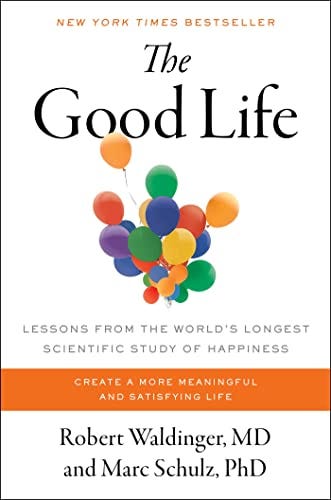Published early 2023, this book is the long awaited summation of the world’s longest scientific study of happiness. (Co-author Robert Waldinger gave the massively popular TED talk “What Makes a Good Life” in 2015 for those more inclined to audiovisual digestion of this important content).
Though following thousands of people from diverse backgrounds and socioeconomic status throughout the span of entire lives, the findings of this study were quite unambiguous. So to get straight to the point:
“Good relationships are significant enough that if we had to take all eighty-four years of the Harvard study and boil it down to a single principle for living, one life investment that is supported by similar findings across a wide variety of other studies it would be this: Good relationships keep us healthier and happier. Period.
p.10
Nutrition, physical activity, and all the usual suspects were found to be critical as always, but above all, “the people who were the most satisfied in their relationships at age 50 were the healthiest (mentally and physically) at age 80.” (p.23)
The authors anecdotally belabor this essential point for a few hundred pages — well worth reading if only to allow the sheer weight of evidence pile up in your mind — but I will only briefly mention two other insightful takeaways:
Having someone that you love with you can quite literally lessen pain. See also this fascinating 2008 study where participants were asked estimate the steepness of a hill and it was discovered that “participants accompanied by a friend estimated a hill to be less steep when compared to participants who were alone.” Friends make hard things less hard.
You are less likely to die from all sorts of mortality risks if you have good relationships. Reams of studies have found, for example, that people who regularly attend church (and hence have social support networks) tend to live significantly longer than those who do not.1
In short, good relationships are the elixir of life and fountain of youth.
Oh but how to cultivate those blessed bonds that sustain us just so? The authors have a few suggestions:
Pay attention. We now live in what some have called the attention economy. The best we can muster these days is ‘continuous partial attention’ eternally lit by the bluelight haze of smartphone screens. Turn it off. Pay attention.
The power of generosity. As Mahmoud Barghouti put it in his novel I Saw Ramallah: “Love is the confusion of roles between the giver and the taker.” Try giving more than you are comfortable giving — see what happens.
Learn new dance steps. The way things have been do not have to be the way things will be forever and ever. Each day is a new chance to try something new.
Radical curiosity. Ask real questions. Get to the heart of things. Dwell on all the things you have might not have any clue about. What is it like to be in their shoes? Find out. And listen.
“Listening is a magnetic and strange thing, a creative force. The friends who listen to us are the ones we move toward. When we are listened to, it creates us, makes us unfold and expand.”
- Karl Menninger
Aristotle long ago remarked that “Friendship is a thing most necessary to life, since without friends no one would choose to live, though possessed of all other advantages.” A few millennia later this Harvard study verifies what we already knew deep down. As the current loneliness epidemic, an infernal virus of our own making, continues in its path of desolation, slowly but surely we will be forced to return to this oldest wisdom of all — that what matters most in the long run is those beside us.
Bruce, Marino A., Bettina M. Beech, Dulcie Kermah, Shanelle Bailey, Nicole Phillips, Harlan P. Jones, Janice V. Bowie, et al. “Religious Service Attendance and Mortality among Older Black Men.” PLOS ONE 17, no. 9 (September 2, 2022): e0273806. https://doi.org/10.1371/journal.pone.0273806.
Bruce, Marino A., David Martins, Kenrik Duru, Bettina M. Beech, Mario Sims, Nina Harawa, Roberto Vargas, et al. “Church Attendance, Allostatic Load and Mortality in Middle Aged Adults.” PLOS ONE 12, no. 5 (May 16, 2017): e0177618. https://doi.org/10.1371/journal.pone.0177618.
Kim, Jibum, Tom W. Smith, and Jeong-han Kang. “Religious Affiliation, Religious Service Attendance, and Mortality.” Journal of Religion and Health 54, no. 6 (December 2015): 2052–72. https://doi.org/10.1007/s10943-014-9902-7.
Li, Shanshan, Meir J. Stampfer, David R. Williams, and Tyler J. VanderWeele. “Association of Religious Service Attendance With Mortality Among Women.” JAMA Internal Medicine 176, no. 6 (June 1, 2016): 777–85. https://doi.org/10.1001/jamainternmed.2016.1615.
Litwin, Howard. “What Really Matters in the Social Network–Mortality Association? A Multivariate Examination among Older Jewish-Israelis.” European Journal of Ageing 4, no. 2 (June 1, 2007): 71–82. https://doi.org/10.1007/s10433-007-0048-2.
McCullough, M. E., W. T. Hoyt, D. B. Larson, H. G. Koenig, and C. Thoresen. “Religious Involvement and Mortality: A Meta-Analytic Review.” Health Psychology: Official Journal of the Division of Health Psychology, American Psychological Association 19, no. 3 (May 2000): 211–22. https://doi.org/10.1037//0278-6133.19.3.211.
Musick, Marc A., James S. House, and David R. Williams. “Attendance at Religious Services and Mortality in a National Sample.” Journal of Health and Social Behavior 45, no. 2 (June 2004): 198–213. https://doi.org/10.1177/002214650404500206.
Oman, D., and D. Reed. “Religion and Mortality among the Community-Dwelling Elderly.” American Journal of Public Health 88, no. 10 (October 1998): 1469–75. https://doi.org/10.2105/ajph.88.10.1469.
Strawbridge, W. J., R. D. Cohen, S. J. Shema, and G. A. Kaplan. “Frequent Attendance at Religious Services and Mortality over 28 Years.” American Journal of Public Health 87, no. 6 (June 1997): 957–61. https://doi.org/10.2105/ajph.87.6.957.
“Study Says Churchgoers Live Longer than More Secular Peers.” Accessed April 7, 2023. https://www.ncronline.org/news/study-says-churchgoers-live-longer-more-secular-peers.
Time. “You Asked: Do Religious People Live Longer?,” February 15, 2018. https://time.com/5159848/do-religious-people-live-longer/.
Wallace, Laura E., Rebecca Anthony, Christian M. End, and Baldwin M. Way. “Does Religion Stave Off the Grave? Religious Affiliation in One’s Obituary and Longevity.” Social Psychological and Personality Science 10, no. 5 (July 1, 2019): 662–70. https://doi.org/10.1177/1948550618779820.
WebMD. “Spirituality May Help People Live Longer.” Accessed April 7, 2023. https://www.webmd.com/balance/features/spirituality-may-help-people-live-longer.






